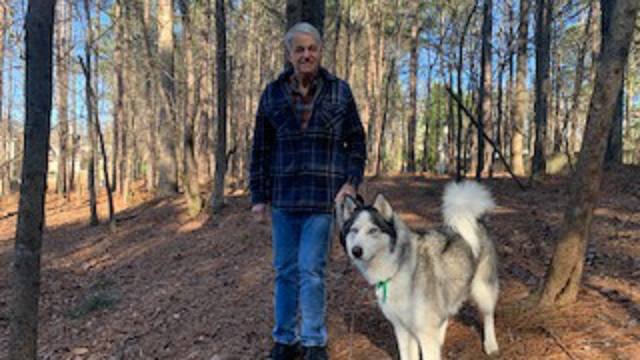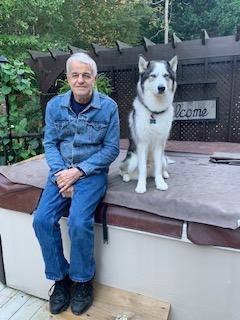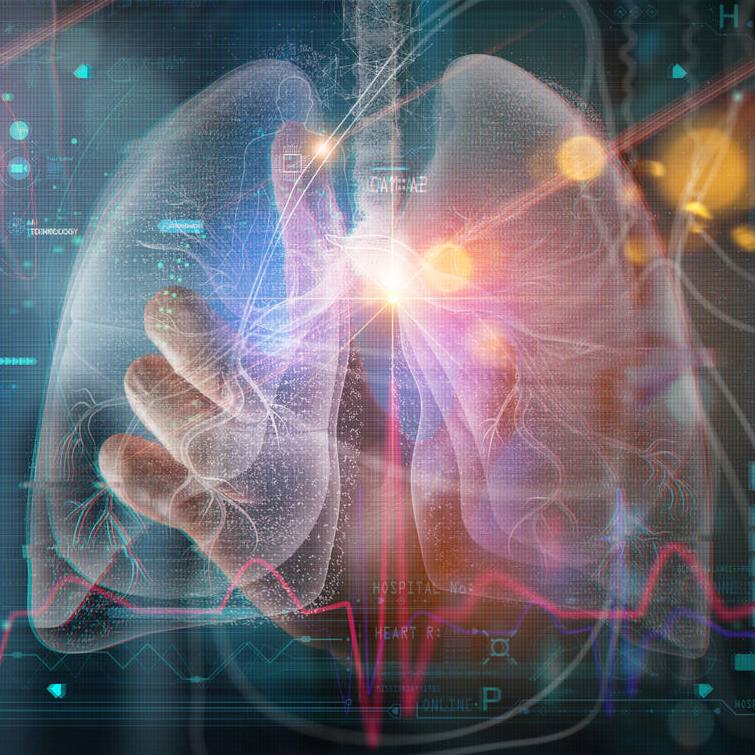-
Sharing Mayo Clinic: Georgia man with neuroendocrine cancer gains quality of life thanks to new nuclear med therapy

Editor's note: This story is written by Robert Sobotka, 75. In 2016, he was diagnosed with a mass on pancreas and multiple tumors in his liver.
Walking up a steep and long hill in the woods behind our house in Woodstock, Georgia, I notice that I’m not as short-of-breath as I used to be — before open-heart surgery, which was performed May 26, 2021. Bandit, my daughter’s Alaskan Husky, eager to go faster, helps me a bit, pulling on his leash. But I can make it up on my own now.
I go about 3-miles daily. It's my routine, which started as part of my recovery from the surgery, along with work outs on an elliptical machine and light weights. Walking gives me time to reflect on my cancer journey.
I never expected to be here, walking these hills, and planning to return to the best quality of life that I can achieve. About five years ago, a local oncologist told me I had, at most, 2 years left to live.
I have neuroendocrine cancer — hallmarked by a huge tumor on the tail of my pancreas and several metastatic lesions on the liver, too numerous to treat during primary tumor surgery performed June 30, 2016. I tried three different drug treatments for the cancer, but they destroyed my quality of life and the tumors kept growing. Good friends had recommended Mayo Clinic after their experiences receiving treatment for a different cancer. So, after the first treatment was unsuccessful, I visited Mayo Clinic in Rochester, Minnesota, which has a neuroendocrine care center. I met with oncologist Thorvardur R. Halfdanarson, M.D., who recommended the second treatment. This treatment was administered orally so we administered and monitored the results locally through my local oncologist. This treatment was also unsuccessful. We then tried a third treatment which I stopped due to toxicity. In June 2018, I decided to stop cancer treatment all together.
But before “signing off” completely, I decided to visit Mayo in Rochester again.
After some tests, oncologist Steven Alberts, M.D., M.P.H., told me I may be a candidate for peptide receptor radionuclide therapy (PRRT), a new treatment that the Food and Drug Administration had recently approved for this type of tumors. The therapy is delivered intravenously, and it delivers targeted radiation to cancer cells. I had read about it before my visit to Mayo because it was already in use in Europe, but I thought it was unlikely I could receive it, especially since it's radioactive and it requires special equipment and specially trained people to administer it. And with my late diagnosis and the high tumor load on the liver, I doubted that I would benefit from the treatment. But should I reconsider?
After our visit to Mayo, my wife and I drove from Rochester to my childhood hometown in Missouri and attended a family reunion in the Kansas City area. Siblings, cousins and all the folks at the reunion encouraged me to go ahead with it, and they spoke highly of Mayo Clinic. I realized I had little to lose and everything to gain.
I transferred my care to Mayo Clinic’s campus in Florida, which is more conveniently located to the Atlanta area where I now live. I met oncologist Jason Starr, D.O., and received my first PRRT treatment on September 18, 2018 — nine months after the FDA approved the therapy for the United States — and had three more infusions, each eight weeks apart.
I had a fantastic response to the treatment. From September of 2018 to October of 2019, tumor markers plummeted by 98%, and by March of 2020, the largest tumors had shrunk to about 25% of their size before the treatment. More importantly, my quality of life had improved dramatically. I believe regular exercise and emphasizing life’s positives are very important factors in successful cancer treatment. No one knows what the future holds, but I have ultimate confidence in my team at Mayo.
On a follow up visit in August 2020, however, an MRI showed that tumors had begun enlarging again. Dr. Starr and I, along with folks from Nuclear Medicine, discussed our options. Many doctors may have stopped at that point, but the Mayo team did not give up. They decided we could go ahead with two more PRRT infusions. I received the additional treatments in December 2020 and January 2021. Once again, the tumors shrunk. Images from April and July 2021 showed the shrunken tumors' size remained stable.
An MRI in October 2021, though, showed the tumors had begun enlarging again. In January 2022, they had grown a bit more. But in addition to their expertise, Mayo Clinic’s staff has always emphasized the positive. And as always, Mayo had an option.
As a former repair center owner/operator and technician, I look at this journey as if I were working on an old truck. If you can't buy a new one, you must just fix what you can to keep it going a little longer. And perform all the maintenance on time. I keep walking about three miles a day.
In March 2022, I underwent a blandembolization procedure which, after mapping the blood supply to tumors allowed radiologist Ricardo Paz-Fumagalli, M.D., to block the blood flow that feeds many of the tumors causing tumors to die.
So far, I've tolerated the aftereffects well and every day I am feeling better. We'll get another MRI soon, then we'll know more about the success of the procedure.
No one knows, of course, what the end of the story will be. Everyone reacts differently to treatments. But we know that I've had about five years more good quality life already than was originally expected. So, the story ending will be happy regardless.
Bandit and I are almost finished with our walk. We passed four small turtles along the way, and Bandit is pulling at the leash again. But this time it’s because he wants to chase a big, beautiful buck deer standing among the trees. As I hold Bandit back, I’m thanking God and the hard-working folks at Mayo Clinic and other health care institutions. Because of them, I’m still alive, independent, and able to enjoy the good things in life, like my family, fresh air, wildlife, and trees.








